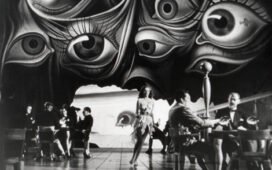“This is supposed to be my farewell tour,” says Ozzy Osbourne in a clip included in the Biography television documentary above. He then gives the finger and adds, “We’ll see.” The year was 1993, and indeed, there turned out to have been much more to come for the former frontman of Black Sabbath, the band that opened the floodgates — or perhaps hellgates — of heavy metal. After an impoverished childhood spent playing in the bomb sites of postwar Birmingham, Osbourne hopped from job to job, including one failed stint at a slaughterhouse and another as a criminal. He then turned singer, receiving a PA system from his father and forming a blues group with a few local musicians. People pay good money to see scary movies, they one day reckoned, so why not make scary music?
The time was the late nineteen-sixties, when listeners approached record albums as quasi-cinematic experiences. Taking their name from Mario Bava’s anthology horror film, which had come out a few years before, Black Sabbath delivered on expectations many weren’t even aware they had. Today, anyone can put on an early Black Sabbath album and identify the music as heavy metal, not a world apart from any of its newer variants.
But more than half a century ago, the world had never heard anything quite like it: there was the much-intensified low end of the sound, with its tuned-down, distorted guitars liable to break into energetic riffs, as well as the flamboyantly dark themes. On top of it all, Osbourne somehow managed to imbue the words, even when delivered in a wallowing or mumbled manner, with a paradoxical clarity and exuberance.
Osbourne’s existing tendencies toward disorder were sent into self-destructive overdrive by success. Anyone would have put money on the odds of his early death, yet he managed to come back from disasters both personal and professional — many of them inflicted by his own substance-fueled Jekyll-and-Hyde personality — again and again. Hence the title of the Biography episode, The Nine Lives of Ozzy Osbourne. For fans who missed out on Black Sabbath’s reign, there was Ozzfest, Osbourne’s rock festival that occurred around the world between the mid-nineties and the late twenty-tens. The reality show The Osbournes made him a pop-cultural icon beloved even by viewers with no interest in his music. Ultimately, his real farewell didn’t come to pass until Black Sabbath’s final live set, which came as the culmination of a day-long festival put on in his hometown less than three weeks before his death. And though Ozzy Osbourne may now be gone, the Prince of Darkness persona he created will remain heavy metal’s animating spirit.
The Nine Lives of Ozzy Osbourne will be added to our collection of Free Documentaries, a subset of our collection, 4,000+ Free Movies Online: Great Classics, Indies, Noir, Westerns, Documentaries & More.
Related content:
Ozzy Osbourne’s Guitarist Zakk Wylde Plays Black Sabbath on a Hello Kitty Guitar
Who Invented Heavy Metal Music?: A Search for Origins
Kids Orchestra Plays Ozzy Osbourne’s “Crazy Train” and Zeppelin’s “Kashmir”
1980s Metalhead Kids Are Alright: Scientific Study Shows That They Became Well-Adjusted Adults
Based in Seoul, Colin Marshall writes and broadcasts on cities, language, and culture. His projects include the Substack newsletter Books on Cities and the book The Stateless City: a Walk through 21st-Century Los Angeles. Follow him on the social network formerly known as Twitter at @colinmarshall.















